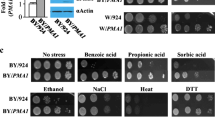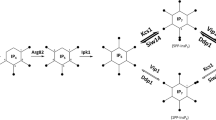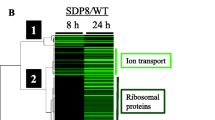Abstract
We have isolated mutants ofSaccharomyces cerevisiae with an increased sensitivity to oxidative stress. Allpos9 mutants (pos for peroxide sensitivity) were hypersensitive to methylviologene, hyperbaric oxygen or hydrogen peroxide, but grew similarly to the wild-type under all other conditions tested. Isolation and sequencing of the respectivePOS9 gene revealed that it was identical toSKN7. The predicted Skn7/Pos9 protein possesses a domain with high homology to prokaryotic response regulators. These regulatory proteins are part of a simple signalling cascade termed a “two-component system”, where a phosphorylation signal of a histidine kinase is transferred to a conserved aspartate residue of the response regulator. To test the functional role of the respective aspartate residue of Skn7/Pos9 protein in oxidative stress, we mutagenized this residue in vitro to alanine, arginine and glutamate. Only the glutamate allele (D427 to E) was able to rescue the hydrogen peroxide-sensitivity ofpos9 mutants. By fusion experiments with the Gal4 DNA-binding domain we identified the isolated response regulator-like domain as a novel eukaryotic domain sufficient for gene activation. Whereas this hybrid protein activated transcription of alacZ reporter gene under aerobic conditions, no activation was observed under anaerobic conditions, indicating that the response regulator domain is involved in a signalling reaction. Two-hybrid investigations also suggest an oligomerization of the Pos9 protein. Our results indicate that a two-component system is involved in the oxidative-stress response of yeast.
Similar content being viewed by others
References
Bermingham-McDonogh O, Gralla E, Valentine JS (1988) The copper, zinc-superoxide dismutase gene ofSaccharomyces cerevisiae: cloning, sequencing and biological activity. Proc Natl Acad Sci USA 85:4789–4793
Brown JL, North S, Bussey H (1993)SKN7, a yeast multicopysuppressor of a mutation affecting cell wallβ-glucan assembly, encodes for a product with domains homologous to prokaryotic two-component regulators and to heat-shock transcription factors. J Bacteriol 175:6908–6915
Brown JL, Bussey H, Stewart RC (1994) Yeast Skn7p functions in a eukarytotic two-component regulatory pathway. EMBO J 13:5186–5194
Carlson M, Botstein D (1982) Two differentially regulated mRNAs with different 5′-ends encode secreted and intracellular forms of yeast invertase. Cell 28:145–154
Chae HZ, Kim I-H, Kim K, Rhee SG (1993) Cloning, sequenzing and mutation of thiol-specific antioxidant gene ofSaccharomyces cerevisiae. J Biol Chem 268:16815–16821
Chae HZ, Chung SJ, Rhee SG (1994) Thioredoxin-dependent peroxide reductase from yeast. J Biol Chem 269:27670–27678
Chang C, Kwok SF, Bleeker AB, Meyerowitz EM (1993)Arabidopsis ethylene-response geneETR1: similarity of product to two-component regulators. Science 262:539–544
Cohen G, Rapatz W, Ruis H (1988) Sequence of theSaccharomyces cerevisiae CTA1 gene and the amino-acid sequence of catalase A derived from it. Eur J Biochem 176:159–163
Collinson L (1994) GenBank Ace No L35342
Culotta VC, Howards WR, Liu XF (1994)CRS5 encodes a metallothioneine-like protein inSaccharomyces cerevisiae. J Biol Chem 269:1001–1008
Fields S, Song O (1989) A novel genetic system to detect protein-protein interactions. Nature 340:245–247
Forsburg SL, Guarente L (1989) Identification and characterization ofHAP4, a third component of the CCAAT-bound Hap2/Hap3 heteromer. Genes Dev 3:1166–1178
Fowell E (1952) Sodium acetate as a sporulation media for yeasta. Nature 170:578–580
Fridovich I (1978) The biology of oxygen radicals. Science 201:875–879
Fürst P, Hu S, Hackett R, Hamer D (1988) Copper activates metallothioneine gene transcription by altering the confirmation of a specific DNA-binding protein. Cell 55:705–717
Gan Z-R (1991) Yeast thioredoxin genes. J Biol Chem 266:1692–1696
Gietz RD, Sugino A (1988) New yeast-Escherichia coli shuttle vectors constructed with in vitro mutagenized yeast genes lacking six-pair restriction sites. Gene 74:527–534
Gralla EB, Thiele DJ, Silar P, Valentine JS (1991)ACE1, a copper-dependent transcription factor, activates expression of the yeast copper, zinc superoxide dismutase gene. Proc Natl Acad Sci USA 88:8558–8562
Hahn S, Pinkham J, Wei R, Miller R, Guarente L (1988) TheHAP3 regulatory locus ofSaccharomyces cerevisiae encodes overlapping transcripts. Mol Cell Biol 8:655–663
Hall DE, Baldesten A, Holmgren A, Reichard P (1971) The yeast gene for thioredoxin. Eur J Biochem 23:328–335
Harshman KD, Moye-Rowley WS, Parker CS (1988) Transcriptional activation by the SV40 AP-1 recognition element in yeast is mediated by a factor similar to AP-1 that is distinct fromGCN4. Cell 531:321–330
Hartig A, Ruis H (1986) Nucleotide sequence of theSaccharomyces cerevisiae CTT1-gene and deduced amino-acid sequence of yeast catalase T. Eur J Biochem 160:487–490
Hertle K, Haase E, Brendel M (1991) TheSNQ3 gene ofSaccharomyces cerevisiae confers hyper-resistance to several functional unrelated chemicals. Curr Genet 19:429–433
Hussain M, Lenard J (1991) Characterization ofPDR4, aSaccharomyces cerevisiae gene that confers pleiotropic drug resistance in high-copy number. Gene 101:149–152
Jungmann J, Reins H-A, Lee J, Romeo A, Hassett R, Kosman D, Jentsch S (1993)MAC1, a nuclear regulatory protein related to Cu-dependent transcription factors is involved in Cu/Fe utilization and stress resistance in yeast. EMBO J 12:5051–5056
Kaput J, Goltz S, Blobel G (1982) Nucleotide sequence of the yeast nuclear gene for cytochromec peroxidase precursor: functional implications of the presequence for protein transport into mitochondria. J Biol Chem 257:15054–15058
Karin M, Najarian R, Haslinger A, Valenzuela P, Welch J, Fogel S (1984) Primary structure and transcription of an amplified genetic locus: theCUP1 locus of yeast. Proc Natl Acad Sci USA 81:337–341
Klebe RJ, Harris JV Sharp D, Douglas MG (1983) A general method for poly ethylene glycol-induced transformation of bacteria and yeast. Gene 25:333–341
Krems B, Charizanis C, Entian K-D (1994) Genbank Acc Do X83031
Krems B, Charizanis C, Entian K-D (1995) Mutants ofSaccharomyces cerevisiae sensitive to oxidative and osmotic stress. Cur Genet 37:427–433
Landt O, Grunert HP, Hahn U (1990) A general method for rapid site-directed mutagenesis using the polymerase chain reaction. Gene 96:125–128
Laurent BC, Treitel MA, Carlson M (1990) TheSNF5 gene ofSaccharomyces cerevisiae is a glutamine- and proline-rich transcriptional activator that affects expression of a broad spectrum of genes. Mol Cell Biol 10:5616–5625
Liu XF, Culotta VC (1994) The requirement for yeast superoxide dismutase is bypassed through mutations inBSD2, a novel metal homeostasis gene. Mol Cell Biol 14:7037–7045
Maeda T, Wurgler-Murphy SM, Saito H (1994) A two-component system that regulates an osmosensing MAP kinase cascade in yeast. Nature 369:242–245
Marchler G, Schüller C, Adam G, Ruis H (1993) ASaccharomyces cerevisiae UAS element controlled by protein kinase A activates transcription in response to a variety of stress conditions. EMBO J 12:1997–2003
Marres CAM, van Loon APGM, Oudshoorn P, van Steeg H, Grivell LA, Slater EC (1985) Nucleotide sequence of the nuclear gene coding for manganese superoxide dismutase of yeast mitochondria, a gene previously assumed to code for the Rieske iron-sulphur protein. Eur J Biochem 147:153–161
Miller JH (1972) Experiments in molecular generics. Cold Spring Harbor Labaratory Press, Cold Spring Harbor, New York
Muller EGD (1991) Thioredoxin deficiency in yeast prolongs S phase and shortens the G1 interval of the cell cycle. J Biol Chem 266:9194–9202
Myers AM, Tzagoloff A, Kinney DM, Lusty CS (1986) Yeast shuttle and integrative vectors with multiple cloning sites suitable for construction oflacZ fusions. Gene 45:299–310
Nogae I, Johnston M (1990) Isolation of theZWF1 gene ofSaccharomyces cerevisiae, encoding glucose-6-phosphate dehydrogenase. Gene 96:161–169
O'Hara PJ, Horowitz H, Eichinger H, Young ET (1988) The yeastADR6 gene encodes homopolymeric aminoacid sequences and a potential metalbinding domain. Nucleic Acids Res 16:10153–10169
Ohtake Y, Yabuuchi S (1991) Molecular cloning of theγ-glutamyl-cysteinyl synthetase gene ofSaccharomyces cerevisiae. Yeast 7:953–961
Ota IM, Varshavsky A (1993) A yeast protein similar to bacterial two-component regulators. Science 262:566–569
Parkinson JS (1993) Signal transduction schemes of bacteria. Cell 73:857–871
Pinkham JH, Oleson JT, Guarente LP (1987) Sequence and nuclear localization of theSaccharomyces cerevisiae Hap2 protein, a transcriptional activator. Mol Cell Biol 7:578–585
Rowley K (1994) Genbank Acc No Z38061
Sambrook J, Fritsch EF, Maniatis T (1989) Molecular cloning: a laboratory manual. Cold Spring Harbor Laboratory Press, Cold Spring Harbor, New York
Sanger F, Nicklen S, Coulson AR (1977) DNA-sequencing with chain-terminating inhibitors. Proc Natl Acad Sci USA 74:5463–5467
Scharf KD, Rose S, Zott W, Schoeff F, Nover L (1990) Three tomato genes code for heat-stress transcription factors with a region of remarkable homology to the DNA-binding domain of the yeast HSF. EMBO J 9:4495–4501
Schnell N, Entian K-D (1991) Identification and characterization of aSaccharomyces cerevisiae gene (PAR1) conferring resistance to iron chelators. Eur J Biochem 200:487–493
Schnell N, Krems B, Entian K-D (1992) ThePAR1 (YAP1/SNQ3) gene ofSaccharomyces cerevisiae, a c-jun homologue, is involved in oxygen metabolism. Curr Genet 21:269–273
Sharp PM, Cowe E (1991) Synonymous codon usage inSaccharomyces cerevisiae. Yeast 7:657–678
Sorger PK, Pelham HRB (1988) Yeast heat shock factor is an essential DNA-binding protein that exhibits temperature-dependent phosphorylation. Cell 54:855–864
Szczypka MS, Thiele DJ (1989) A cystein-rich nuclear protein activates yeast metallothioneine gene transcription. Mol Cell Biol 9:421–429
Thomas D, Cherest H, Surdin-Kerjan Y (1991) Identification of the structural gene for glucose-6-phosphate dehydrogenase in yeast. EMBO J 10:547–553
Wu A-L, Moye-Rowley WS (1994)GSH1, which encodesγ-glutamylcsteine synthetase, is a target gene for yAP-1 transcriptional regulation. Mol Cell Biol 14:5832–5839
Zamenhoff S (1957) Preparation and assay of deoxyribonucleic acids from animal tissue. Methods Enzymol 3:696–704
Author information
Authors and Affiliations
Additional information
Communicated by F. K. Zimmermann
Rights and permissions
About this article
Cite this article
Krems, B., Charizanis, C. & Entian, KD. The response regulator-like protein Pos9/Skn7 ofSaccharomyces cerevisiae is involved in oxidative stress resistance. Curr Genet 29, 327–334 (1996). https://doi.org/10.1007/BF02208613
Received:
Issue Date:
DOI: https://doi.org/10.1007/BF02208613




